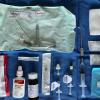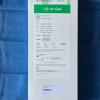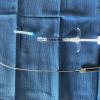Initiated by Brady Anderson MD and Matt Hoffman MD PhD on 12-11-2022
see also: Injectable substances for injection laryngoplasty and Injection Laryngoplasty for Vocal Fold Paralysis and Glottic Incompetence
General Considerations
- Indications - vocal fold hypomobility/immobility with glottic insufficiency and associated dysphagia and weak cough
- Particularly relevant for patients after cardiothoracic operations in whom there is risk of nerve injury and importance of post-operative cough strength is critical
- In one cohort of 14 patients, vocal fold injection augmentation increased peak cough airflow from pre-injection measurements (95% CI, 10-75 L/min increase) (Dion et al., 2017)
- Contraindications - strong gag reflex, procedural anxiety, inability to sit still during the procedure
- Alternatives
- Deferral of treatment to the outpatient setting
- Injection augmentation under general anesthetic
Pre-procedure Preparation
- No bolus feeds 3 hours beforehand
- Calculate maximum dose of local anesthetic appropriate for the patient
- Anticoagulation
- Anticoagulation should be noted but does not need to be held for procedure provided transoral route is used
- Patient voice should be noted including GRBAS rating and comments on weakness, breathiness, roughness, strain, projection, diplophonia, paralytic falsetto
- Ensure mobility of the contralateral vocal fold is normal.
- For patients with new onset vocal fold immobility without preceding neck/chest surgery but with preceding prolonged intubation, consider cricoarytenoid joint fixation. This can be diagnosed by palpation of the cricoarytenoid joint under topical anesthesia at bedside (with the curved Abraham cannula) or under general anesthesia, depending on degree of suspicion.
Consent
- Describe Procedure - "We will spray your nose and throat with numbing spray. We use a small camera passed through your nose to visualize your vocal cords. You will stick your tongue out. We will gently hold your tongue with a piece of gauze and pass a device through your mouth to apply numbing medicine to your vocal cords. Once you are numb, we will pass a second device through your mouth to perform the injection."
- Risks and Complications - Bleeding, infection, hoarseness, airway swelling, hypersensitivity reaction to filler, lack of improvement in voice or swallow function, need for further procedures
Room Setup, Instruments and Equipment
- Patient seated in chair or on edge of bed. If seated on edge of bed, a nurse or nurse assistant is helpful to support the patient from side/behind.
- Patient facing toward the provider in the sniffing position
- Bedside video tower (either Storz tower or Olympus tower) on the patient's left, monitor facing the provider
- Instruments
- Endoscope - Flexible fiberoptic laryngoscope or Slim XP190 bronchoscope with connections to video tower
- 4cc 4% lidocaine
- 1cc 1:1 4% lidocaine with 1% phenylephrine with atomizer tip
- Hurricane spray
- Oxymetazoline nasal spray
- Two 3cc Luer lock syringes
- 1 cc slip tip syringe
- 25g needle
- Dry gauze
- Abraham curved cannula
- Orotracheal injector with needle
- Carboxymethylcellulose injection material (Prolaryn Gel; has to be Prolaryn Gel (carboxymethylcellulose), not Prolaryn Plus (CaHA))
- Prolaryn Gel can be ordered from inpatient pharmacy by searching for “Prolaryn Gel” in Epic. Please order 2 of the 1-ml syringes. Having 2 available is good for a backup. If only one is used, which will almost always be the case, the other one can be returned to pharmacy.
Procedure
- Use atomizer syringe to apply 1 cc of 1:1 4% lidocaine with 1% phenylephrine to the bilateral nasal cavities
- Apply hurricane spray to oropharynx, including base of tongue, soft palate, and posterior pharyngeal wall
- Assistant advances flexible fiberoptic laryngoscope or Slim bronchoscope through the nasal cavity (usually left) to level of oropharynx
- Using dry gauze, the provider gently pulls the tongue forward
- The provider connects a syringe of 4% lidocaine to the Abraham curved cannula, then advances it through the oral cavity to drip 4% lidocaine onto the vocal folds
- Connect orotracheal injector to syringe containing Prolaryn Gel, and advance injector through oral cavity and oropharynx to the level of the glottis
- Take care not to pierce the soft tissue of the tongue, palate, pharynx or supraglottis
- Inject filler material into the true vocal fold, about 2-3 mm anterolateral to the vocal process at the superior arcuate line
- Inject into thyroarytenoid muscle
- Avoid injection into the superficial lamina propria
- Inject until the concavity of the true vocal fold becomes convex (slightly "over-filled"), as some of the filling may quickly fade
- Images may be captured using the video monitor to compare pre- and post-procedure appearance and function of the vocal folds
- Remove the orotracheal injector from the oral cavity. The assistant may then remove the endoscope from the patient's nasal cavity
Post-operative considerations
- To reduce the likelihood of injectate extrusion, the patient may be instructed to refrain from speaking for the remainder of the day. Speaking may be resumed on post-procedure day 1
- Repeat swallow assessment may be performed by speech pathology team 48 hours later at their discretion
Follow-Up
- Follow-up in the outpatient setting may be scheduled 2-4 weeks following the patient's inpatient discharge
References
Dion G, Achlatis E, Teng S, et al. Changes in peak airflow measurement during maximal cough after vocal fold augmentation in patients with glottic insufficiency. JAMA Otolaryngol Head Neck Surg 2017 Nov; 143(11):1141-5.
Abu-Ghanem S, Rudy S, Deane S, Tsai SW, Shih LC, Damrose EJ, Sung CK. Early Injection Laryngoplasty After Surgery: 30 Cases and Proposed Aspiration Assessment Protocol. J Voice. 2020 Jan;34(1):121-126. doi: 10.1016/j.jvoice.2018.08.011. Epub 2018 Oct 16. PMID: 30340927.
Reder L, Bertelsen C, Angajala V, O'Dell K, Fisher L. Hospitalized Patients With New-Onset Vocal Fold Immobility Warrant Inpatient Injection Laryngoplasty. Laryngoscope. 2021 Jan;131(1):115-120. doi: 10.1002/lary.28606. Epub 2020 Mar 16. PMID: 32176334.


